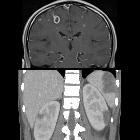Infective endocarditis








Infective endocarditis is defined as infection of the endocardium. It commonly affects the valve leaflets and chordae tendineae, as well as prosthetic valves and implanted devices.
Epidemiology
Infective endocarditis has an estimated general prevalence of 3 to 9 cases per 100,000. Intravenous drug users are at increased risk with approximately 2 cases per 1,000 in this patient group. It is more common in men than women (>2:1). In the general population, it affects more individuals older than 65 years .
Clinical presentation
ECG
Non-specific, but electrocardiographic abnormalities common and may include:
- prolongation of the PR interval
- with progressive degrees of AV block
- sinus tachycardia
- right atrial enlargement
- bundle branch blocks
- left or right ventricular strain pattern
- voltage criteria for hypertrophy with regional ST depression and T wave inversion
- may be secondary to conduction system invasion or underlying predisposition (e.g. aortic stenosis)
Pathology
The following conditions appear to play critical roles in the creation of an endocarditic lesion :
- endocardial abnormality
- endocardial inflammation
- endothelial injury from central lines and other forms of cardiovascular instrumentation
- valvular disease including prosthetic valves
- bacteremia
- microorganism access to the bloodstream from oral, genitourinary, or gastrointestinal sources
- trauma
- intravenous and subcutaneous injections
- microbial properties and associated components
- microbial virulence properties such as adhesion proteins and tissue-destructive factors
- microbial quantity
- particulate and diluent materials
- repetition of microbial entry into the bloodstream
Once the endocarditic lesion is initiated, the clotting pathway catalyzes vegetation formation. The microbes become buried in the vegetation and may form a biofilm around them, thereby becoming inaccessible to immune cells or antibiotic drugs for clearance and eradication. Endocarditic vegetation is the pathologic hallmark of infective endocarditis and commonly appears as an irregular, mobile or fixed mass and is usually attached to the endocardium on the low-pressure side of a valve, chordae tendinae or ascending aorta. Vegetation fragments can break off and undergo embolization, causing more conspicuous clinical signs and symptoms of infection like pneumonia and stroke.
Radiographic features
Plain radiograph
Chest radiographic findings are non-specific and may show opacities suggestive of underlying pneumonia and septic pulmonary emboli. Patients with valve leaflet destruction may manifest with signs of congestive heart failure. The cardiac silhouette may be enlarged due to pericardial effusion. Some patients may also show pleural effusion.
Echocardiography
Echocardiography is the primary imaging modality of cardiac infections. It has been integrated into the modified Duke criteria for diagnosis of infective endocarditis. Transesophageal echocardiography is superior to transthoracic investigations; the latter should only be used as a screening modality in low-risk patients with a low pre-test probability/clinical suspicion .
Vegetations have the following cardinal features on echocardiography :
- isoechoic to tissue
- independent movement
- preferentially congregate on the leading edge of the valve
- on the lower-pressure side of the valve
- most common location of mitral valve involvement would be the anterior leaflet of the mitral valve on the atrial side of the MV
- in prosthetic valves, however, they will most commonly be located at the junction between the sewing ring and the valvular annulus
- on the lower-pressure side of the valve
- associated with valvular regurgitation
- vast majority cause failure of leaflet coaptation
- may also perforate valve, which will appear as an endocardial discontinuity
- often results in multiple, aliased regurgitant jets on the high-pressure side of the affected valve
- may also perforate valve, which will appear as an endocardial discontinuity
- argues against infective endocarditis if regurgitation jet is not present
- vast majority cause failure of leaflet coaptation
Other possible echocardiographic findings:
- valvular stenosis
- vegetations may, less commonly, obstruct valves
- dehiscence of prosthetic valve
- jet vegetations
- secondary locus of vegetations where regurgitant jet meets the endocardium
- pseudoaneurysm
- anechoic space with pulsatile flow
- communicates with the cardiac chamber lumen
- abscess
- irregular collection of heterogeneous echogenicity directly adjacent to the affected valve
CT
Cardiac CT angiography may demonstrate endocarditic vegetations as hypoattenuating filling defects surrounded by intravenous contrast material. Cardiac-gated CT angiography can also demonstrate valve tissue destruction and perivalvular extension with pseudoaneurysm or fistula formation. CT may miss small vegetations.
MRI
Cardiac MRI can detect valvular vegetation features of infective endocarditis. The appearance of vegetations depends on the imaging sequence used and ranges from low to intermediate signal intensity and isointense to muscle with balanced steady-state free precession (SSFP) and inversion-recovery sequences. Post-gadolinium images may show enhancement of the vegetations and abscess. In the absence of vegetations, MRI can demonstrate delayed enhancement representing endothelial inflammation of the cardiovascular structures, which can contribute to the diagnosis and treatment planning of infective endocarditis . Cardiac MR imaging also allows quantification of regurgitation fraction.
Treatment and prognosis
Infective endocarditis is a disease with high morbidity and mortality, even with appropriate diagnosis and therapy . With treatment, which includes antibiotics and surgery, the mean in-hospital mortality of infective endocarditis is 15-20% with 1-year mortality approaching 40% . If untreated, infective endocarditis is invariably fatal.
Complications
Septic emboli occur in 12-40% of infective endocarditis cases . They can affect any organ or tissue in the body with an arterial supply:
- central nervous system (most common)
- lungs (especially in right-sided infective endocarditis)
- spleen
- kidneys
- liver
- musculoskeletal system
Other complications:
- paravalvular, annular or aortic abscess / aortic root abscess
- mycotic aneurysms, including intracranial mycotic aneurysms
- heart block
- valve dehiscence or severe dysfunction
- intracardiac fistula
Differential diagnosis
Differential diagnosis of vegetations include:
Siehe auch:
und weiter:

 Assoziationen und Differentialdiagnosen zu infektiöse Endokarditis:
Assoziationen und Differentialdiagnosen zu infektiöse Endokarditis:

